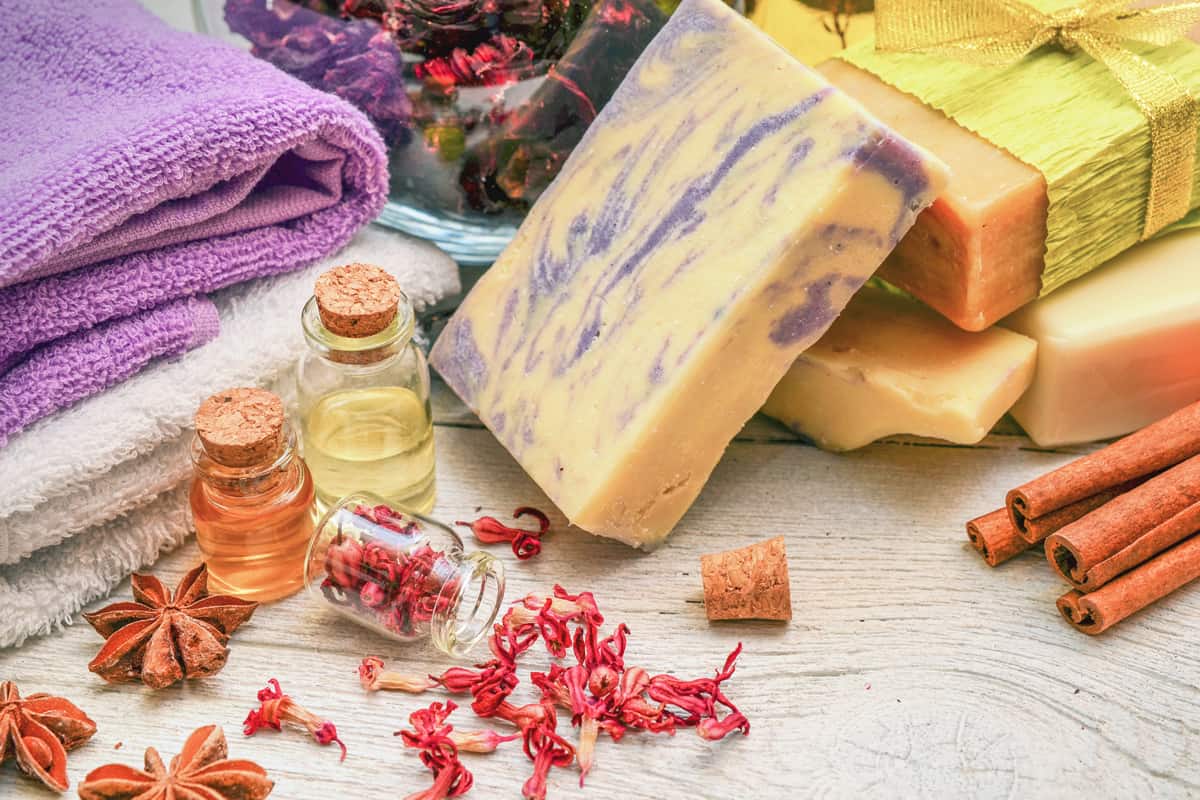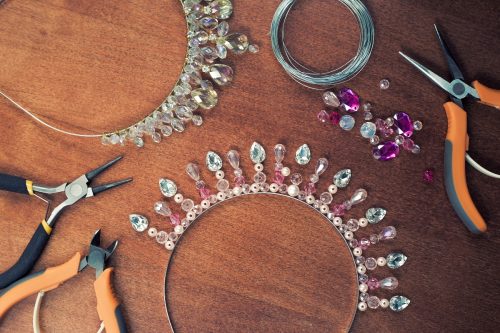As a beginning soap maker, it's easy to get caught up in purchasing all the latest equipment. However, you can easily get started in soap making with a minimum of supplies. Often items you already own can be repurposed to use in soap making. We've researched whether a loaf pan works as a soap mold, and the answer might surprise you.
A loaf pan can be easily used as a soap mold. Ensure the pan is heat safe and made from either glass, stainless steel, or silicone material. If you are new to soap making, before you invest in lots of different mold shapes, try shopping in your kitchen for molds first. Many containers you already own can easily be used to mold soap.
In this post, you'll learn about how to use common household items as molds along with other tips and tricks for using soap molds. Keep reading for soap molding ideas, tips, and tricks.

How To Use A Loaf Pan As A Soap Mold
Soap molds come in a variety of shapes and sizes. While there are molds for purchase specifically designed for soap making, everyday household containers can also be used to shape soaps.
A common technique for soap making is to form the soap into a "loaf." The loaf is then sliced (yes, just like bread) to form a smaller slice or bar. This technique yields several smaller bars without molding each bar individually. When using this technique, you can adjust the thickness of your slice to give the bar shape you desire.

You can purchase loaf molds specifically designed for soap making. This mold set contains a silicone mold, wooden holder, and slicers for smooth or wavy edges.
Click here to see it on Amazon.
Fortunately, you can also use a regular loaf pan from your kitchen as an alternative for molding soap. There are a few things you want to consider when choosing a loaf pan to use as a mold:
- Is it heat safe? The melted soap base will be hot. Make sure your loaf pan is a material that can hold up to heat. A good rule of thumb is to make sure the pan is a material that can be safely used in the microwave.
- Use stainless steel if you choose a metal pan. Glass pans are a great option, but stainless steel will also work. Do not use aluminum or tin. These metals react with sodium hydroxide and can release dangerous gas. Appropriate materials include silicone, plastic, glass, or stainless steel.
- Using a non-flexible pan like glass or stainless steel, line the pan with freezer paper. This will make it easier to remove the soap after it has hardened.
To use your loaf pan as a soap mold, first chose the container you would like to use. Make sure it is clean and dry. If the pan is silicone, you can pour the melted soap base directly into it. Line rigid containers with freezer paper to make removing the hardened soap easier. Pour the melted soap into the container and set it on a firm surface to harden.
Click here to see glass loaf pans available on Amazon.
At times you may want a shape other than a slice or bar. Think creatively when looking at containers you may have in your home that can be used as soap molds. Some other molding soap options include silicone baking cups or pans, food storage containers, shoe boxes, and milk cartons.
These silicone baking cups would make perfect molds for small soaps.
Click here to find them on Amazon.
If you have a set of food storage containers of various sizes, you can make many different shapes and sizes of soaps. This set would give you options for round or bar-shaped soaps.
Click here to find this storage container set on Amazon.
How Big Is A Soap Loaf?
Soap loaves can be made in many sizes. The size of the loaf will determine how many individual bars can be cut from it. A one-pound loaf pan will generally yield four slices of soap. If you are making large batches, you may want a larger loaf that will give more slices. This article at Natural Soap Wholesale gives information regarding loaf sizes and how many slices to expect based on the size.
Can You Make A Mold Out Of Household Items?
You can make a mold out of many different household items. Plastic containers, loaf pans, food storage containers, cleaned food cans, and silicone bakeware make great options for soap molds. Just follow the rules above regarding heat safety and materials when choosing a container for a mold. Remember that after the soap is hard, you need to remove it. Flexible molds make this easy, but for rigid molds like glass or stainless steel, use a freezer paper liner to help you remove the hardened soap.
Once you have found a heat-safe container in the desired shape, you are ready to mold. If the container is rigid, line it with freezer paper to aid in the release after hardening. Melt your soap base and pour it into the container. Place the container on a level surface and let it sit to harden. Do not move the container until the soap is hard. Once completely hardened, remove the soap from the container.
This clever YouTube video shows how to use a Pringles container as a soap mold.
How Do You Keep Soap From Sticking To A Mold?
Once your soap has hardened and is ready to release from the mold, you can slide out easily. Soap that sticks is frustrating, and you can damage the soap, trying to remove it. Silicone molds work very well for easy release as they can be peeled away from the soap.
When using more rigid containers, there are a few other ways to keep the soap from sticking. Lining a mold with freezer paper will allow the soap to be easily lifted out of the container.
Soap molds with fancy shapes may be more difficult to remove the finished soap from. Spraying the mold with a small amount of cooking spray or applying a thin layer of mineral oil can help the finished soap slide out more easily.
If you are still having difficulty removing the soap, try placing it in the refrigerator for about 30-minutes and then thawing for 1- to 2-minutes before attempting to remove it again. If the soap is still not coming out, try running warm water over the back of the mold while applying gentle pressure to release the soap.
How Do You Swirl Soap In A Loaf Mold?
Add interest to your soap by creating bars with more than one color. The technique for this involves layering and swirling colors throughout the bar. To achieve this, pour alternating lines of color into the mold and then use a small dowel rod or chopstick to drag through the colors creating a swirling effect.

This YouTube video shows how to swirl multiple colors in a loaf mold.
How Long Do You Leave Soap In A Mold?
How long your soap will need to stay in a mold to harden depends on the type of soap process you've used. On average, soap will take one to 15 days to harden. Melt and pour soaps, which are the easiest techniques for beginners, might be ready in as little as 4- to 6-hours. Melt and pour soaps use a ready-made soap base, which is melted to liquify and then poured into the mold to shape. Melt and pour soaps do not require lye, which can be tricky for beginning soap makers.
Cold process soaps use lye and various types of oils mixed to create the soap. Cold process soaps require a longer time in the mold as they harden. Two to three days is the average time needed to harden a cold process soap.
The final method of soap making is a hot process. This process also uses lye. Hot process soaps need an average of one to two days to harden in the mold.
If you unmold your soap too soon, it will be soft. This can make marks and dents in your finished soap. It will also make it difficult to cut slices from loaves if the soap is too soft. Make sure your soap has completely hardened before you attempt to unmold it.
In Summary
Molding handmade soap is a way to create unique shapes. Many mold shapes and designs are available for purchase; however, you can get started in soapmaking using simple items you may already have in your kitchen. Don't be afraid to think outside the box when choosing potential molds; just make sure the mold is heat safe, sturdy, and made of an appropriate material.





![Read more about the article Can You Glue Fabric To Leather? [Products & Steps Included]](https://craftsbliss.com/wp-content/uploads/2023/01/In-workroom-girl-makes-purse-with-brushglueleather.-500x333.jpg)


![Read more about the article Does Crochet Shrink? [And How To Un-Shrink It]](https://craftsbliss.com/wp-content/uploads/2020/12/Casual-fashion-lookbook-concept-with-stylish-crochet-bag-500x333.jpg)

![Read more about the article How To Drill Holes In Glass Beads [8 Steps To Follow]](https://craftsbliss.com/wp-content/uploads/2021/05/Heap-of-shining-transparent-multicolored-faceted-glass-beads-500x333.jpg)